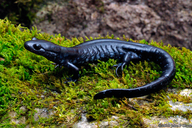|
Ambystoma laterale Hallowell, 1856
Blue-spotted Salamander Subgenus: Xiphonura | family: Ambystomatidae genus: Ambystoma |
| Species Description: Hallowell, E. (1856). Description of several species of Urodela, with remarks on the geographical distribution of the Caducibranchiata Division of these animals and their classification. Proceedings of the Academy of Natural Sciences of Philadelphia 8, 6–11. | |
 © 2010 John P. Clare (1 of 37) |
|
|
|
Description Distribution and Habitat Country distribution from AmphibiaWeb's database: Canada, United States U.S. state distribution from AmphibiaWeb's database: Connecticut, Iowa, Illinois, Indiana, Massachusetts, Maine, Michigan, Minnesota, New Hampshire, New Jersey, New York, Ohio, Vermont, Wisconsin Canadian province distribution from AmphibiaWeb's database: Manitoba, New Brunswick, Newfoundland and Labrador, Nova Scotia, Ontario, Prince Edward Island, Quebec
Life History, Abundance, Activity, and Special Behaviors Comments In the Ambystoma genus, there are unisexual populations that can hybridize with A. jeffersonianum, A. laterale, A. texanum, A. trigrinum, and A. barbouri to create ploidy-elevated offspring. They can range from diploid to pentaploid and there are over 20 different nuclear genomic combinations. Most Ambystoma unisexuals have an A. laterale nuclear genome, while the other types of donated genomes can replace each other, as seen in recent populations of A. barbouri being the replacement donor for A. jeffersonianum. Ambystoma unisexuals’ mtDNA is most similar to A. barbouri, however A. barbouri is the least common sperm donor. Tetraploid and pentaploid unisexuals tend to have a higher mortality rate than triploid unisexuals (Bogart et al. 2009). This species was featured as News of the Week on 14 March 2022: One of the silverlinings of the COVID-19 pandemic has been reduced human activities on the landscape (sometimes called the "anthropause"), notably a decrease in motor vehicle traffic during lockdown. This provided a unique opportunity while monitoring amphibians in northeastern United States. Using a community citizen science project, The Maine Big Night: Amphibian Migration Monitoring, Leclair et al. (2021) collected data on migrating amphibians crossing roads at sites throughout Maine during amphibian mating seasons, from March to May in 2018 through 2021. Almost 8,000 amphibians representing 16 species were recorded at 199 sites surveyed during these four years. They found a 50% decrease in frog mortality in 2020 compared to the other survey years, mainly due to decreased frog deaths in March and April. Wildlife collision data for other species in Maine (e.g., deer, turkeys, moose) were consistent with this trend of lower wildlife mortality in spring 2020. Thus, there was a significant reduction in frog deaths in Maine because of the traffic reductions during the COVID-19 lockdown. In the same time period, increasing precipitation correlated with increasing frog deaths, but not in salamanders, suggesting that environmental factors influence frog and salamander movements differently. Roads can be significant barriers to amphibian migrations; thus, even small changes can have large effects for these populations, especially for frogs. (Written by Carol Spencer)
References
Behler, J.L. and King, F.W. (1996). National Audubon Society Field Guide to North American Reptiles and Amphibians. Knopf, New York, NY. Bogart, JP, Bartoszek, J, Noble, DWA, Bi, K (2009). "Sex in unisexual salamanders: discovery of a new sperm donor with ancient affinities." Heredity, 103, 483-493. [link] Originally submitted by: Kevin Gin (first posted 2003-11-25) Comments by: Nessa Kmetec (updated 2022-10-05)
Edited by: Vance T. Vredenburg (2022-10-05) Species Account Citation: AmphibiaWeb 2022 Ambystoma laterale: Blue-spotted Salamander <https://amphibiaweb.org/species/3836> University of California, Berkeley, CA, USA. Accessed May 22, 2025.
Feedback or comments about this page.
Citation: AmphibiaWeb. 2025. <https://amphibiaweb.org> University of California, Berkeley, CA, USA. Accessed 22 May 2025. AmphibiaWeb's policy on data use. |




 Raffaëlli Account
Raffaëlli Account Map of Life
Map of Life